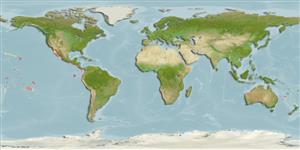>
Anguilliformes (Eels and morays) >
Ophichthidae (Snake eels) > Ophichthinae
Etymology: Myrichthys: Greek, myros, -ou = male of morey eel + Greek, ichthys = fish (Ref. 45335).
More on author: Girard.
Environment: milieu / climate zone / depth range / distribution range
Ökologie
seewasser riff-verbunden; tiefenbereich 0 - 60 m (Ref. 5227). Tropical; 32°N -
Eastern Pacific: Gulf of California to Peru, including the Galapagos Islands.
Size / Gewicht / Alter
Maturity: Lm ? range ? - ? cm
Max length : 74.0 cm TL Männchen/unbestimmt; (Ref. 5227); common length : 60.0 cm TL Männchen/unbestimmt; (Ref. 55763)
Inhabits sandy and muddy bottoms, from shallow waters up to a depth of 25 m. Can be seen at times in daylight searching for prey under rocks and in crevices over rocky bottoms, or buried completely in the sand when inactive (Ref. 6852).
Life cycle and mating behavior
Geschlechtsreife | Fortpflanzung | Ablaichen | Eier | Fecundity | Larven
McCosker, J.E. and R.H. Rosenblatt, 1995. Ophichthidae. Tiesos, serpentones. p. 1326-1341. In W. Fischer, F. Krupp, W. Schneider, C. Sommer, K.E. Carpenter and V. Niem (eds.) Guia FAO para Identification de Especies para lo Fines de la Pesca. Pacifico Centro-Oriental. 3 Vols. FAO, Rome. (Ref. 9328)
IUCN Rote Liste Status (Ref. 130435)
Bedrohung für Menschen
Harmless
Nutzung durch Menschen
Fischereien: nicht kommerziell
Mehr Information
NamenSynonymeMetabolismusRäuberÖkotoxikologieFortpflanzungGeschlechtsreifeAblaichenSpawning aggregationFecundityEierEientwicklung
Alter/Größe
Wachstum
Länge-Gewicht
Länge-Länge
Längenhäufigkeiten
Morphometrie
Morphologie
Larven
Larven Pop.Dyn.
Rekrutierung
Dichte
BRUVS
ReferenzenAquakulturAquakultur ProfilZuchtlinienGenetikElectrophoresesVererbbarkeitKrankheitenVerarbeitungNutrientsMass conversion
Tools
Zusatzinformationen
Download XML
Internet Quellen
Estimates based on models
Preferred temperature (Ref.
123201): 20.5 - 28.7, mean 25.9 °C (based on 80 cells).
Phylogenetic diversity index (Ref.
82804): PD
50 = 0.5005 [Uniqueness, from 0.5 = low to 2.0 = high].
Bayesian length-weight: a=0.00089 (0.00039 - 0.00204), b=3.00 (2.80 - 3.20), in cm total length, based on LWR estimates for this (Sub)family-body shape (Ref.
93245).
Trophic level (Ref.
69278): 3.5 ±0.4 se; based on size and trophs of closest relatives
Widerstandsfähigkeit (Ref.
120179): mittel, Verdopplung der Population dauert 1,4 - 4,4 Jahre. (Preliminary K or Fecundity.).
Fishing Vulnerability (Ref.
59153): Moderate to high vulnerability (50 of 100).
Nutrients (Ref.
124155): Calcium = 38.4 [21.5, 68.0] mg/100g; Iron = 0.511 [0.313, 1.025] mg/100g; Protein = 18.8 [16.5, 21.3] %; Omega3 = 0.111 [0.051, 0.312] g/100g; Selenium = 46.4 [26.9, 90.0] μg/100g; VitaminA = 50.4 [15.2, 149.8] μg/100g; Zinc = 0.95 [0.68, 1.31] mg/100g (wet weight);
